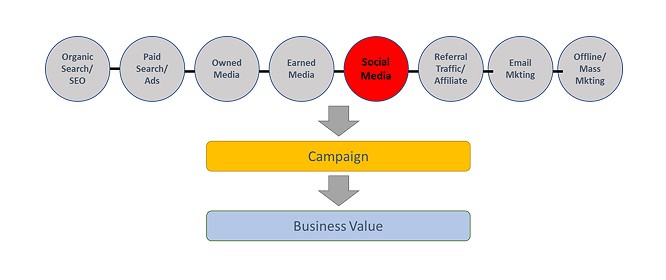In our latest blog the “CTI CustomerUniverse was not created by the Big Bang Theory” my colleague, Mark Janowicz, describes how through a systematic approach, using data and technology, we help businesses glean true insights about their customers. Continuing this important and interesting topic, I’d like to focus on the Social Media Analytics of the CTI solution.
Social media has grown as a marketing channel, so has enthusiasm for its potential to better understand customers and influence their behavior. Companies spend billions on social media campaigns, hoping to capitalize on it. Yet most businesses are unable to quantify the value of their social media efforts. Too often, they confuse a cause and a consequence. For example, it is possible that getting people to follow a brand on social media makes them buy more. However, it’s also possible that those who already have positive feelings toward a brand are more likely to follow it in the first place, and buy more.
Enthusiasts often justify the investments by arguing that attracting social media followers and increasing their exposure to a brand will ultimately increase sales. More and more C-suite executives are telling them to prove it.
Challenges
The harsh reality is social media doesn’t work the way many of us think it does. The act of endorsing a brand on social media alone does not directly affect a customer’s behavior, nor does it influence purchasing by his or her friends and family. Social media is just one of several aspects to an integrated campaign. It is often complementary to other methods. For example, there might be a positive interaction between social media and Search Engine Optimization (SEO), where both results add up or overlay. So, who gets the “credit”?

What to measure?
Marketers often struggle to demonstrate the return on social media investments. Why is it so hard? Because social metrics are often just the intermediate step between linking investments. It is also a time-based process, so it often takes a while for the results to be felt. Therefore, selecting the right metrics, as well as their context, is critical.
Let’s look at part of the customer life-cycle—a journey a prospective buyer will take using social media.
The beginning of the journey is marked by awareness metrics, such as number of visits, members, likes, followers, tweets, impressions, ratings and reviews. They describe the size and quality of our social network. We could also leverage advanced methods to calculate the cohesion score.
As the customer becomes more active, we should look at the level of engagement. For example number of comments, replies and retweets, volume of user-generated content, rate of activity, number of responses to polls/contests/surveys, etc. Network density score, for example, is an analytic assessment the helps measure engagement.
What marketers want to see is the reach. This measures the word-of-mouth for a brand or a product, e.g.: shares, posts on wall, references or citations in other sites. This ultimately leads to an understanding of the share of voice—the positive mentions of your brand as a ratio to the industry competitor. Here is where we begin to identify top influencers and information brokers. Who is spreading the word? Does it come with the negative or positive sentiment? What are the actions we should (or should not) take to encourage the spread?
How to measure?
Remember, the C-suite wants to see proof. We move from the “what to measure” to “how to measure.” This is critical value transfer with any measurement initiative. Therefore, the measurement execution must be properly planned and delivered. When measuring social media impact, first order is to establish a baseline. What were the social baseline metrics before the campaign started? Obviously, you need this to show the incremental effects of marketing effort. As we begin to capture the data, we determine what other activities, campaigns, or events could have impacted the results (e.g. SEO initiative, price change, new product development). Armed with these results, we overlay all the data on a timeline including activities, social data, business data, web traffic data, sentiment metrics, etc., to form a holistic view.
NOTE: When looking for and interpreting patterns, one must be cognizant of data lags. Ideally, metrics associated with the social campaign are improve when combined and correlated with other business metrics, such as Customer Lifetime Value (CLV).
In the next blog, I will demonstrate how to use data and industry leading analytical tools to illuminate the key social metrics. Stay tuned.
Bart Modrzynski
@BartModcom